Abstract
The first three reactions in the catabolism of qainic acid in Neurospora crassa are under the genetic control of the qa gene cluster. This cluster consists of three structural genes encoding three inducible enzymes plus a regulatory gene (qa-1+) whose diffusible product apparently acts in a positive fashion to initiate coordinate synthesis of the three enzymes when an appropriate inducer is present. Genetic and biochemical evidence for both complementing and temperature-sensitive qa-1 alleles indicates that the product of the qa-1+ gene is an oligomeric (multimeric) protein. On the basis of cis-trans tests of appropriate double mutants (plus genetic mapping data for temperature-sensitive mutants), at least certain constitutive mutants (which produce all three qa enzymes in the absence of an inducer) are mutants in the regulatory gene and not in controlling elements such as initiators. The detection of stable (non-revertible) qa-1 intralocus deletion (multisite)mutants provides additional evidence for positive regulation in the qa system. Extensive genetic recombination data provide evidence that the two types of qa-1 mutants--slow-complementing (qa-1-s) and fast-complementing (qa-1-f)--map in discrete, non-overlapping segments of the qa-1 locus. These two distinct types of mutants are hypothesized to produce altered regulatory protein molecules that fail to interact either with a DNA initiator site (qa-1-s types) or with an inducer (qa-1-f types). The striking similarities between the qa system in this lower eukaryote and certain prokaryote operon systems are discussed.
Full text
PDF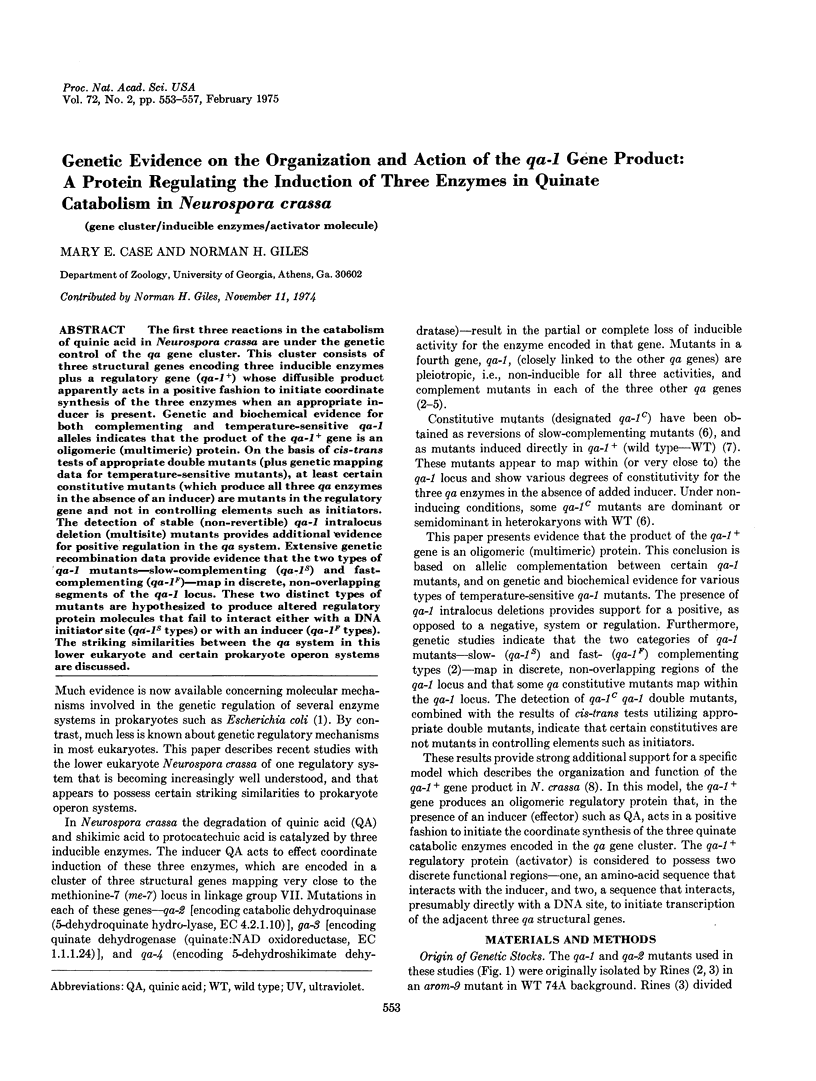
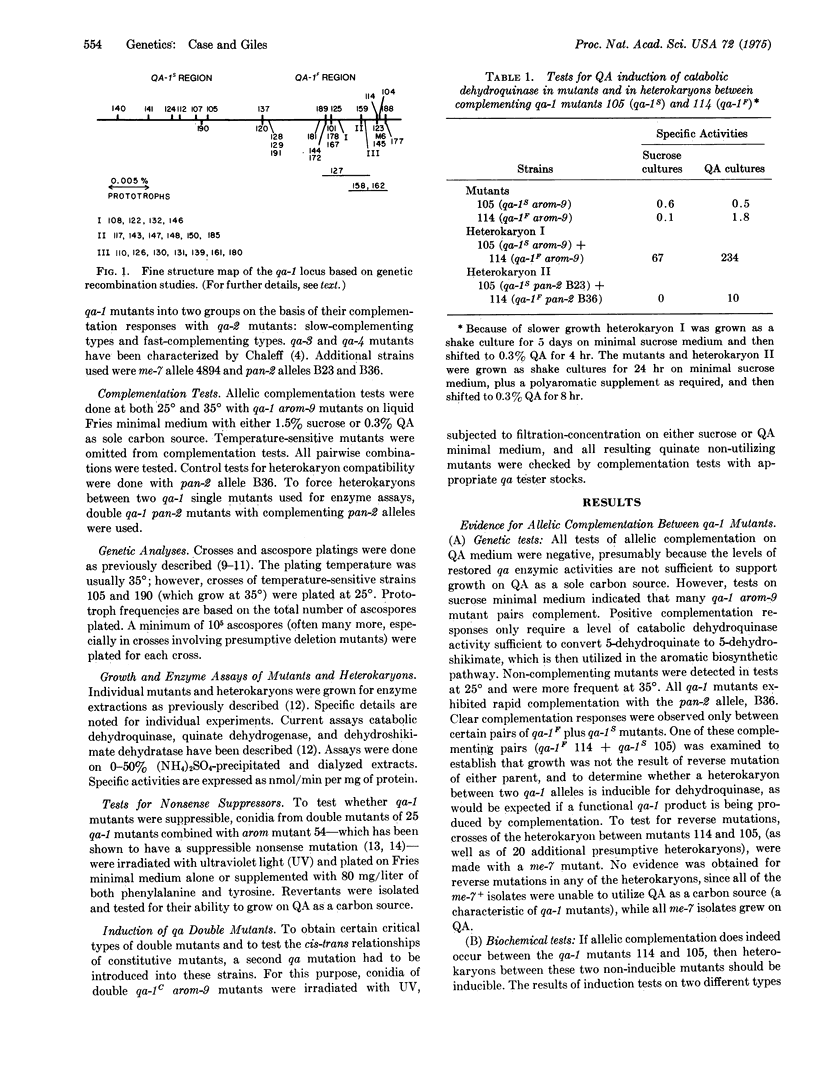
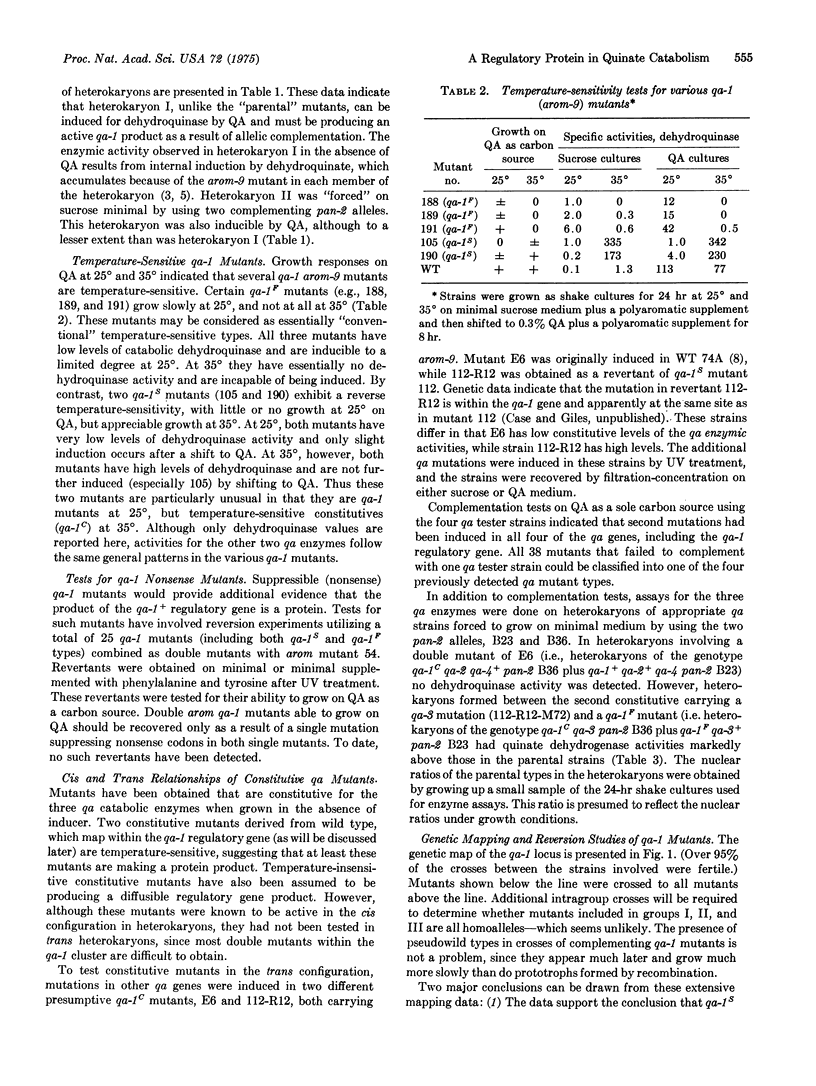
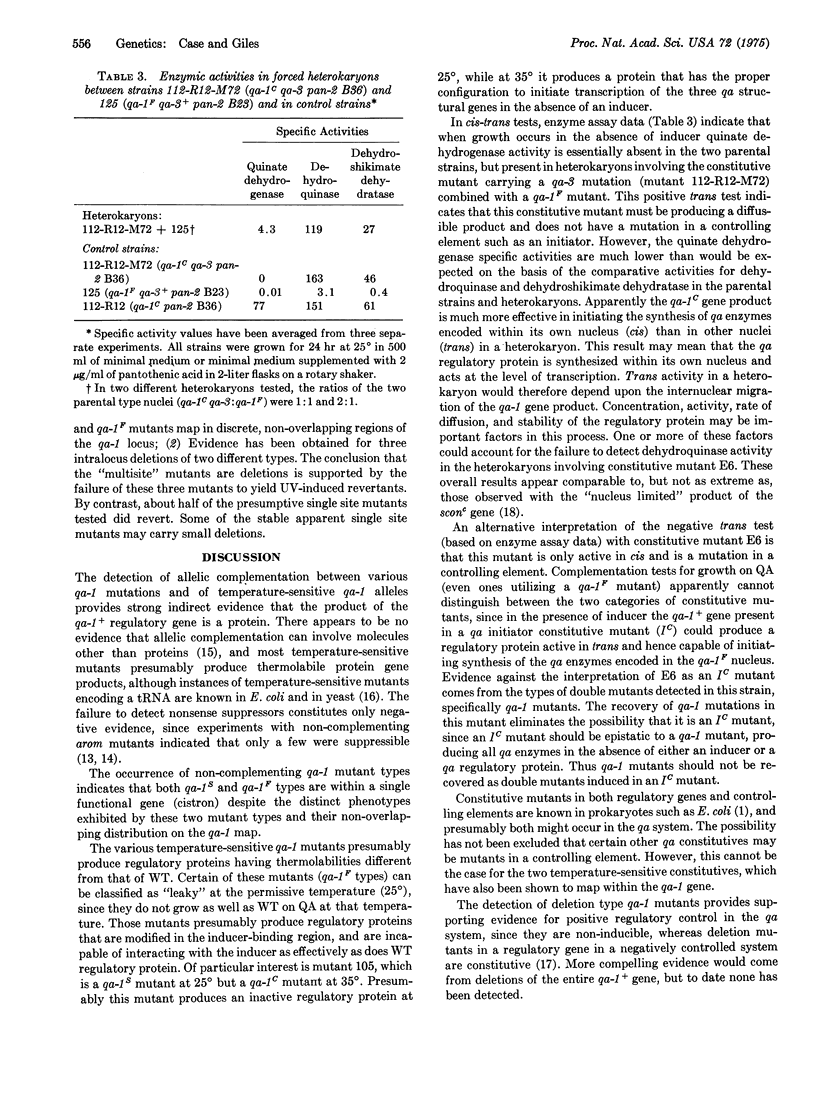
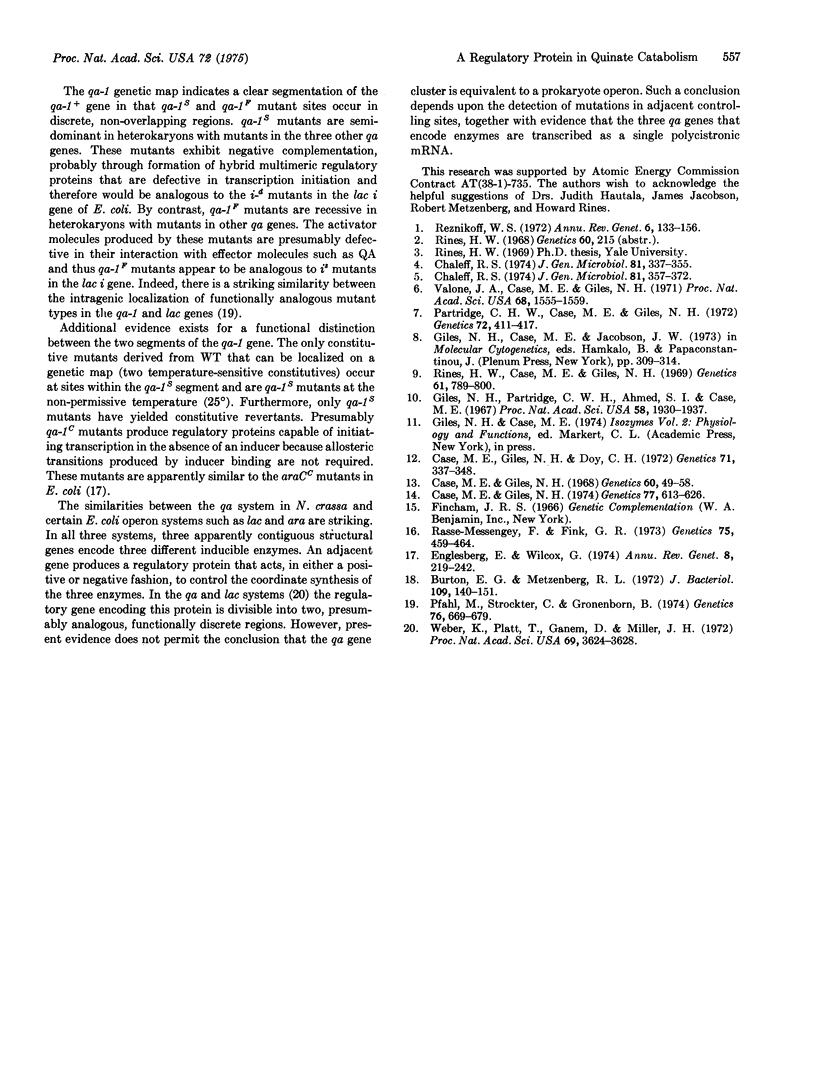
Selected References
These references are in PubMed. This may not be the complete list of references from this article.
- Burton E. G., Metzenberg R. L. Novel mutation causing derepression of several enzymes of sulfur metabolism in Neurospora crassa. J Bacteriol. 1972 Jan;109(1):140–151. doi: 10.1128/jb.109.1.140-151.1972. [DOI] [PMC free article] [PubMed] [Google Scholar]
- Case M. E., Giles N. H., Doy C. H. Genetical and biochemical evidence for further interrelationships between the polyaromatic synthetic and the quinate-shikimate catabolic pathways in Neurospora crassa. Genetics. 1972 Jul;71(3):337–348. doi: 10.1093/genetics/71.3.337. [DOI] [PubMed] [Google Scholar]
- Case M. E., Giles N. H. Evidence for nonsense mutations in the arom gene cluster of Neurospora crassa. Genetics. 1968 Sep;60(1):49–58. doi: 10.1093/genetics/60.1.49. [DOI] [PMC free article] [PubMed] [Google Scholar]
- Case M. E., Giles N. H. Revertants and secondary arom-2 mutants induced in non-complementing mutants in the arom gene cluster of Neurospora crassa. Genetics. 1974 Aug;77(4):613–626. doi: 10.1093/genetics/77.4.613. [DOI] [PMC free article] [PubMed] [Google Scholar]
- Chaleff R. S. The inducible quinate-shikimate catabolic pathway in Neurospora crassa: genetic organization. J Gen Microbiol. 1974 Apr;81(2):337–355. doi: 10.1099/00221287-81-2-337. [DOI] [PubMed] [Google Scholar]
- Chaleff R. S. The inducible quinate-shikimate catabolic pathway in Neurospora crassa: induction and regulation of enzyme synthesis. J Gen Microbiol. 1974 Apr;81(2):357–372. doi: 10.1099/00221287-81-2-357. [DOI] [PubMed] [Google Scholar]
- Englesberg E., Wilcox G. Regulation: positive control. Annu Rev Genet. 1974;8:219–242. doi: 10.1146/annurev.ge.08.120174.001251. [DOI] [PubMed] [Google Scholar]
- Giles N. H., Partridge C. W., Ahmed S. I., Case M. E. The occurrence of two dehydroquinases in Neurospora crassa, one constitutive and one inducible. Proc Natl Acad Sci U S A. 1967 Nov;58(5):1930–1937. doi: 10.1073/pnas.58.5.1930. [DOI] [PMC free article] [PubMed] [Google Scholar]
- Partridge C. W., Case M. E., Giles N. H. Direct induction in wild-type Neurospora crassa of mutants (qa-1 c ) constitutive for the catabolism of quinate and shikimate. Genetics. 1972 Nov;72(3):411–417. doi: 10.1093/genetics/72.3.411. [DOI] [PMC free article] [PubMed] [Google Scholar]
- Pfahl M., Stockter C., Gronenborn B. Genetic analysis of the active sites of lac repressor. Genetics. 1974 Apr;76(4):669–679. doi: 10.1093/genetics/76.4.669. [DOI] [PMC free article] [PubMed] [Google Scholar]
- Rasse-Messenguy F., Fink G. R. Temperature-sensitive nonsense suppressors in yeast. Genetics. 1973 Nov;75(3):459–464. doi: 10.1093/genetics/75.3.459. [DOI] [PMC free article] [PubMed] [Google Scholar]
- Reznikoff W. S. The operon revisited. Annu Rev Genet. 1972;6:133–156. doi: 10.1146/annurev.ge.06.120172.001025. [DOI] [PubMed] [Google Scholar]
- Rines H. W., Case M. E., Giles N. H. Mutants in the arom gene cluster of Neurospora crassa specific for biosynthetic dehydroquinase. Genetics. 1969 Apr;61(4):789–800. doi: 10.1093/genetics/61.4.789. [DOI] [PMC free article] [PubMed] [Google Scholar]
- Valone J. A., Jr, Case M. E., Giles N. H. Constitutive mutants in a regulatory gene exerting positive control of quinic acid catabolism in Neurospora crassa. Proc Natl Acad Sci U S A. 1971 Jul;68(7):1555–1559. doi: 10.1073/pnas.68.7.1555. [DOI] [PMC free article] [PubMed] [Google Scholar]
- Weber K., Platt T., Ganem D., Miller J. H. Altered sequences changing the operator-binding properties of the Lac repressor: colinearity of the repressor protein with the i-gene map. Proc Natl Acad Sci U S A. 1972 Dec;69(12):3624–3628. doi: 10.1073/pnas.69.12.3624. [DOI] [PMC free article] [PubMed] [Google Scholar]


